This article is taken from the creator: Nidhriti Bhowmik
A 5-step process that you can copy for your next blog post

If you asked me five years ago whether I saw myself writing blog posts that people would actually read, let alone get them to rank number one on Google, I would have said no way!
My writing skills were average at best and I didn’t have the money to take the awesome online courses that would teach me how to be better.
To beat all of that, I live in India where content farms and freelancers were dishing out 1,000-word blog posts for $13–15. Didn’t seem lucrative at all.
This was until I started my actual career as a growth specialist for B2B SAAS startups — which minus the buzzwords basically meant finding and implementing cost-effective ways to multiply bottom-line revenues.
In other words, I had to come to terms with the truth — if I was going to attract, engage, and convert high-quality prospects, I had to make my content game strong af.
One thing led to another and before I knew it I was riffing out blog posts that were consistently ranking within the first three search results.
Of course, it involved a lot of sleepless nights trying not only to make sense of SEO but more importantly understanding what makes for engaging people-friendly content. Not to mention a lot (and I mean a lot) of obsessive reading.
So before I dive into the exact process I use to get my blog posts to rank, here’s some juicy proof:
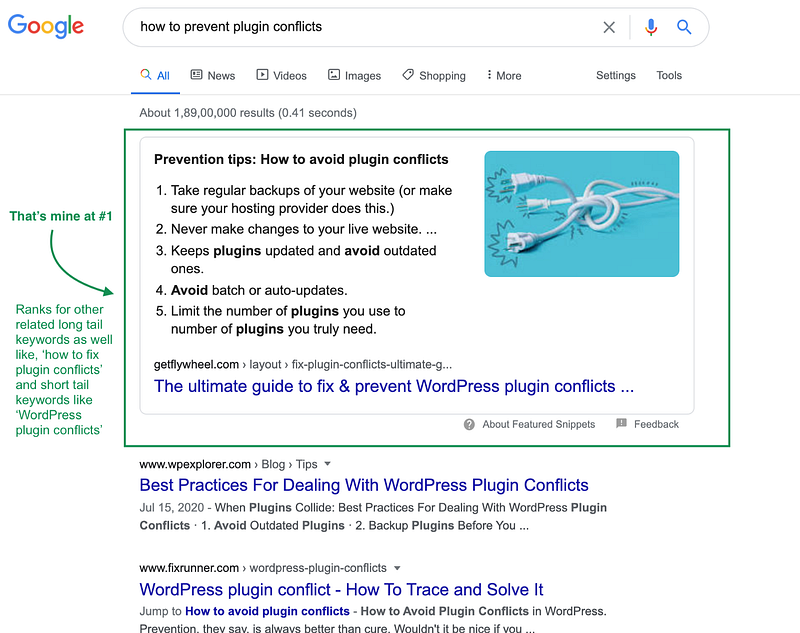
Screenshot provided by the author, taken on the incognito browser after clearing browser cache and history
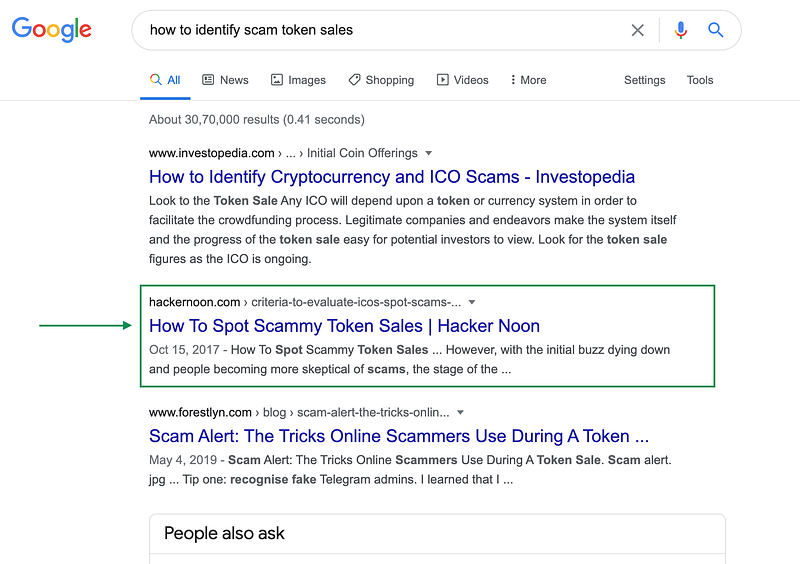
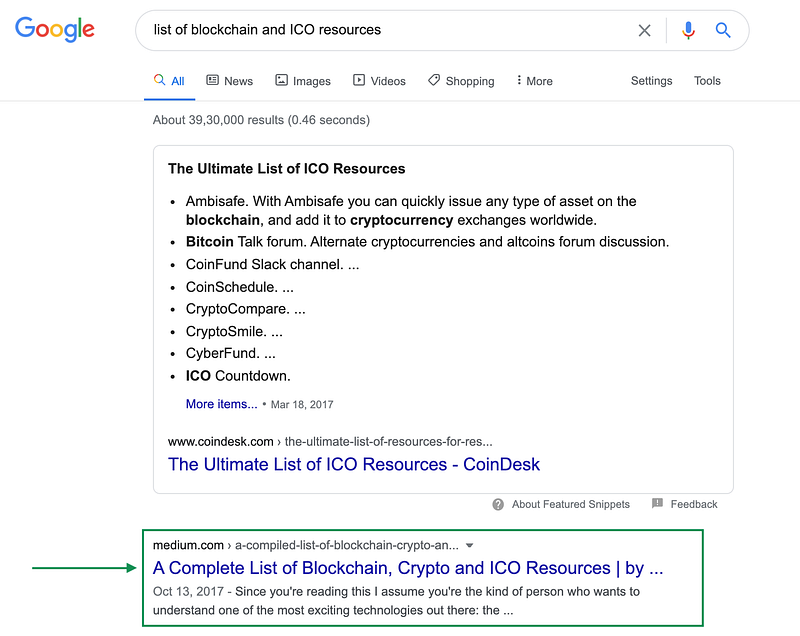
Now that that’s out of the way, I’m going to show you exactly how it’s done.
How I Write Blog Posts That Rank on Search Engines (and You Can Too)
Good news first: It’s actually much easier than you might imagine to create blog posts that do well on search engines. The key is to find the right balance between SEO and writing for your ideal reader.
So without further ado, let’s dive into the process that you can copy to master writing high ranking blog posts over and over again.
Ready? Let’s get into it.
Pick Your Keywords the Right Way
(Aka find what people are searching for)
No surprises here, my process starts with exactly what any content writing, marketing, or SEO wizard will tell you — keyword research. That said, where my process might be a bit different is how I cherry-pick the best keywords.
I typically start with an overall topic.
For the sake of clarity, let’s take an example. Say you represent a marketing agency and want to tackle the subject of ‘email marketing.’
So here ‘email marketing’ is your primary topic.
1. Open a KW research tool
I use Ahref’s. If you’re on a budget, free tools like Google’s Keyword Planner, Ubersuggest, or Keywords Everywhere get the job done just as well.
2. Plugin your topic
For example, ‘email marketing.’ Most tools will let you filter results based on ‘keyword suggestions containing the ‘exact phrase,’ ‘related keywords,’ and ‘questions.’
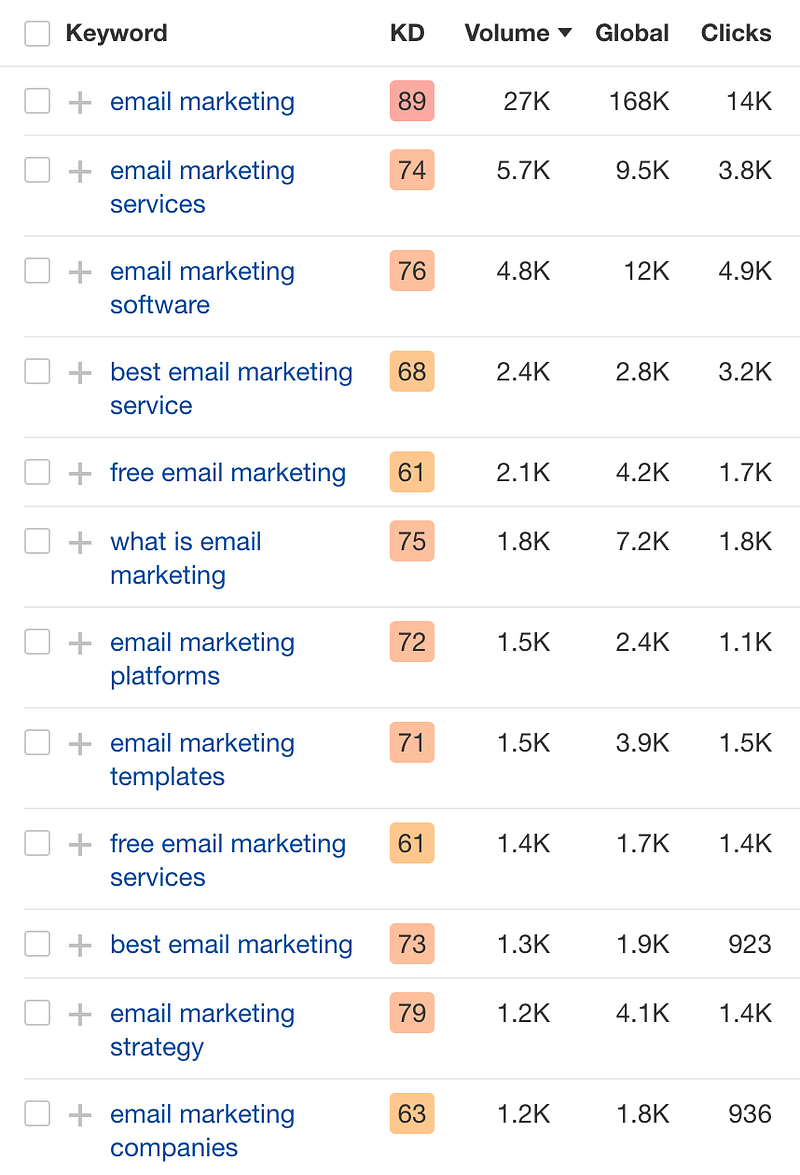
Keywords found for email marketing on Ahref’s
3. Look at the results and shortlist the ones that attract good traffic and are relevant or interesting to you
For email marketing, your short-tail keywords would be email marketing strategies, email marketing templates, email marketing software, email marketing platforms, and so on.
You also want to look at the keyword difficulty. When you’re in a niche that has a lot of competition and traffic volume, chances are there’s already a ton of content that’s ranking well. Naturally, the keyword difficulty can be anywhere between hard and super hard.
Does that mean you can’t beat them? Hell no.
On the contrary, you absolutely can with an article that’s more in-depth or up-to-date. One ingenious way to do that would be to cluster the different short-tail keywords you’ve identified and find the related long-tail keywords that can go together to form the different sections of your long-form blog post (I’ll get into this in Step 4). For the uninitiated, long-tail keywords are basically phrases or questions containing or related to your short-tail keyword.
4. Find related long-tail keywords
Once you’ve identified and clubbed similar short-tail keywords together, you want to go back to the keyword search and plugin those keywords to find the related long-tail keywords.
As I mentioned, when the keyword difficulty is not as low as you’d want it to be, creating a long-form post that is better than everything else that already exists is your best bet.
So in the email marketing example, based on the results you’d probably want to write something that’s titled “The Ultimate Email Marketing Guide for Beginners,” or, “Email Marketing Made Simple: Services, Strategies, and Templates.”
With a behemoth post like that, you could package all the different keywords you’ve identified as the different sections of your post. So in this case you could have H2 headings like:
- What is email marketing
- Creating an email marketing strategy
- How to write a killer email newsletter
- How to send your marketing emails(with subsections titled “best email marketing services,” “platforms to choose from,” and “segmenting and personalizing your emails”)
- 7 ways to grow your email list, etc. You get the drift.
5. Last but not least, you want to go on an incognito Google window and plug in the short and long-tail keywords you’ve identified
From there, have a look at all the results on page one. This way you’ll know how much more in-depth your article needs to be. Not to mention, you’ll realize if you have a different angle that no one has spoken about yet.
Skeleton First, Write After
After a rendevous with keyword research and identification, I move toward drawing out an outline of the blog post I have in mind.
More often than not, you’ll notice that having an outline handy cuts your actual writing time by half.
Not to mention, an outline is ridiculously helpful when you start to lose your flow or deviate from what you intended to share.
To my point, you want to have a skeleton of your blog post that outlines all the key talking points you want to share in the post.
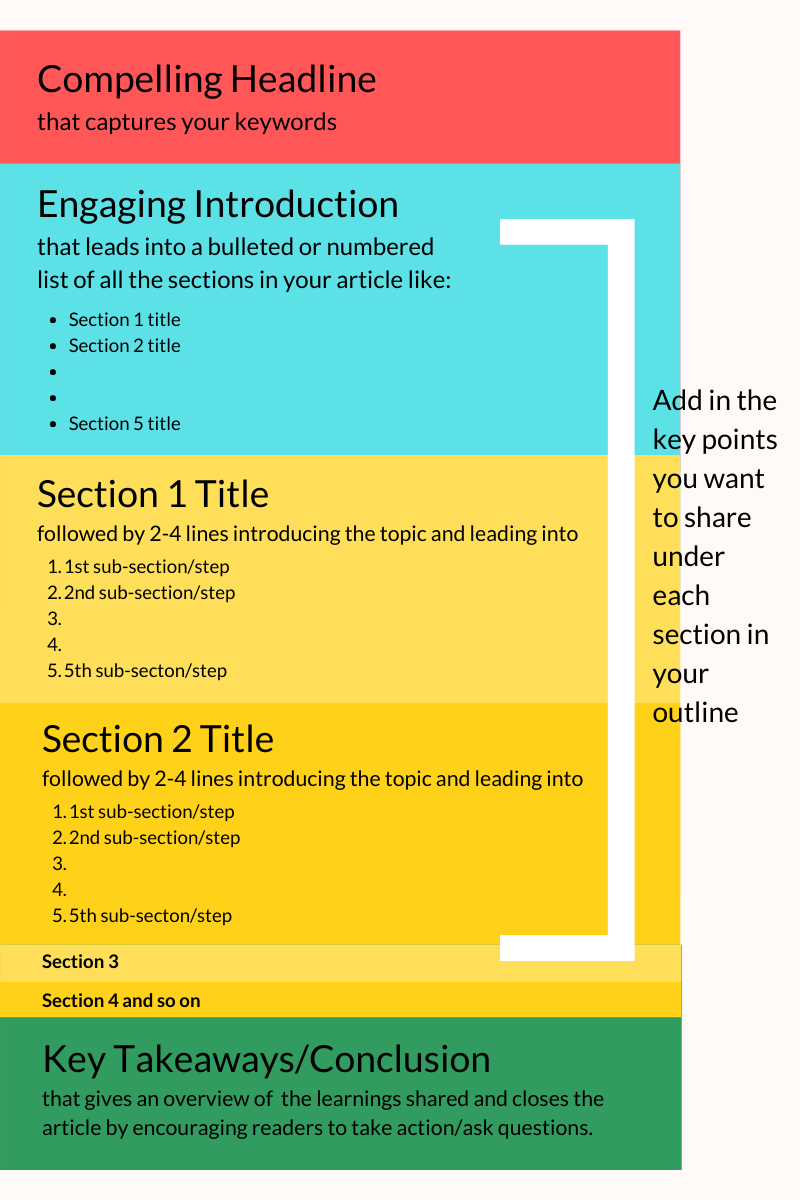
A basic outline of a long-form blog post, Graphic created by the author
To make it even more convenient for yourself, compile the thoughts at the top of your head and jot down the key points you want to share in each section.
Write for Humans, Not Just Search Engines
I’m sure you’ve noticed that the best performing blog posts are also the ones that are packed with real information, leave the jargon out, and all in all, are super engaging to read.
It’s because they’re written not just with search engines in mind, but also the actual people on the other side of the screen.
High performing blog posts never make you yawn.
1. Only address your ideal reader
In my experience of creating blog posts that boast high time-spent metrics, if there’s one thing that I’ve learned it’s this: You should always only address your ideal reader.
You cannot and definitely should not try and write for everyone who might stumble upon your article.
So if you’re writing about email marketing for businesses, address and think only of business owners and marketers.
If you’re writing about sales productivity for sales reps, write for them, not their team leads and bosses.
The moment you put yourself in your readers’ head (which is actually as easy as it sounds), not only will your messaging be clearer, but you’ll also be able to put the spotlight specifically on their pain points, their motivations, and their desired outcomes.
2. Craft SEO friendly headlines that pack a punch
It’s no secret that your headline or post title is super crucial to your SEO — it’s what tells Google the topic and contents of your blog post. Naturally, you want to use your most profitable long-tail keyword, preferably at the beginning of it. However, you also want to make it irresistible enough for searchers to click on it.
That’s where magnetic adjectives and tried-and-tested headline formulae come in.
Take a look at this epic list of words to include in your headline by
to inspire your next jaw-dropping blog post title. I kid you not, she’s got you covered and then some.
3. Hook readers with an intro they can’t help but read
How many times have you opened a blog post, read the first line, and skipped right through the introduction to the first subheading? Too many to count?
Well, if your intro starts off as dry and dull as cracked hands on a cold winter day, you are setting your blog post up for the same treatment.
Instead, you want an intro that captivates readers from the very first word. An intro that keeps them hooked even in the face of a juicy Tinder ping.
I’ll be straight with you — If I take two hours to write a blog post, I spend at least 30 mins of it on the intro. I write it, scrap it, tear my hair, and rewrite it until I’ve pulled out all the stops. Does it mean that you should do the same? Depends on how much hair you’ve got.
A couple of ways you can turn a dull intro into a killer one:
- Start with a personal yet relevant story
- Suprise or controversial intros work wonders. For example: Resumes are dead. Said the HR head of the MNC I work in…
- Set the scene. Example: Picture this: you’re sitting on a pile of cash in your oversized couch overlooking your indoor pool. You don’t have a care in the world. Your bank balance has so many zeroes, you can’t even count. You book tickets to the Bahamas in the middle of the week because you feel like it. What did you do to get there? Small insignificant changes to your personal finance 10 years back. Sounds too good to be true? Well, it doesn’t have to be…
- Open with a question that appeals to the pain point they’re about to solve. Please don’t state obvious stuff like, don’t you want to make your blog posts rank on Google? *rolls eyes*
- Although a tad bit overused, start with a statistic if you’re stuck. For example: Did you know that WordPress users alone produce 70 million blog posts every month? Staggering, right?
Just remember you want your introduction to not only captivate but also encapsulate relevant keywords (no KW stuffing please), tell readers exactly what they can expect from the article, and set the stage for all the info that’s about to follow.
4. Skim the froth and focus on bringing the actionable stuff to the body of your post
As I mentioned, when I’m researching keywords, I automatically pick the ones that answer questions. That way I get to write posts that readers can follow along and actually implement what they read.
A solid way to do this on autopilot is to write long-form guides or the good ol’ step-by-step how-to articles.
Both people and search engines love these articles for a simple reason: they’re actionable.
On the other hand, blog posts that tell you why you should do something without actually showing you how to do it are pretty pointless. It’s what I call froth for thought.
I mean instead of reading this how-to article, would you rather read why you should write blog posts that rank? I bet not.
Make On-Page SEO Your Best Bud

It sucks when on-page SEO (or the lack of it) comes back to bite you after you’ve poured your heart and soul into writing an engaging article.
Now there are a ton of extensive resources and super useful free courses that will teach you the A-Z of blog post optimization so I won’t get into the nitty-gritty details. Have a crack at one of them in your free time — you won’t regret it.
In case it’s all too intimidating, I highly recommend using a tool like Yoast or All in One SEO Pack that will take out the guesswork from on-page SEO. These tools tell you exactly what you need to change or add to your blog post to get it ready for search engines.
Golden tip: Even if you’re not using WordPress to publish your posts, install Yoast into a free WordPress account and copy-paste your post there to get up to speed.
Having said that, I’m going to get into a few factors that are common between all of my high-performing articles. They do well with people and search engines because — you guessed it — they’re optimized for search.
As a general rule of thumb, I always add my identified keywords, related keywords, or their variations in a naturally readable way to:
- Preferably the beginning of the main heading (H1)
- Meta description
- Subheadings (H2, H3)
- Post URL
- Image alt descriptions
I also make sure that my keywords appear throughout the post in a natural manner. No matter how much you’re tempted, stray away from over adding your keywords. Instead of showing you some love Google will end up penalizing you for it.
Other than that, I also add a few internal links pointing to related blog posts and external links to reputed publications with the right anchor words wherever I deem appropriate.
Close With a Bang
Once we’ve written the body of your article, many of us drop the ball when it comes to concluding it. As a matter of fact, it’s as important as your introduction.
There are a couple of ways you can close your article depending on the type of article and the action you want your readers to take:
- List out the key takeaways from the article, especially if it’s a long one (like I’m about to do with this one)
- Summarise the topic and ask for comments or invite questions
- Reassure readers that they can achieve the results they want to by following your guide and redirect them to other related posts on your blog
- Call-to-action for email newsletters or contact forms
That’s How I Make My Blog Posts Rank
IMHO, the biggest takeaway from this article is that if I can make my blog posts rank, anyone can. All you have to do is identify your process and stick with it.
For me, that involves:
- Finding what people are searching for; i.e. the most lucrative keywords
- Clubbing the related ones together to build different sections of my long-form post
- Draw out a skeleton or mind map before writing a single word
- Give the humans that are going to read more importance than the search engines that are going to index it
- Get along with on-page SEO
I hope this article makes you realize that, even if you’re not the best writer in the room, if you follow a process you will see your blog posts on page one and even the number one spot on Google.

Comments